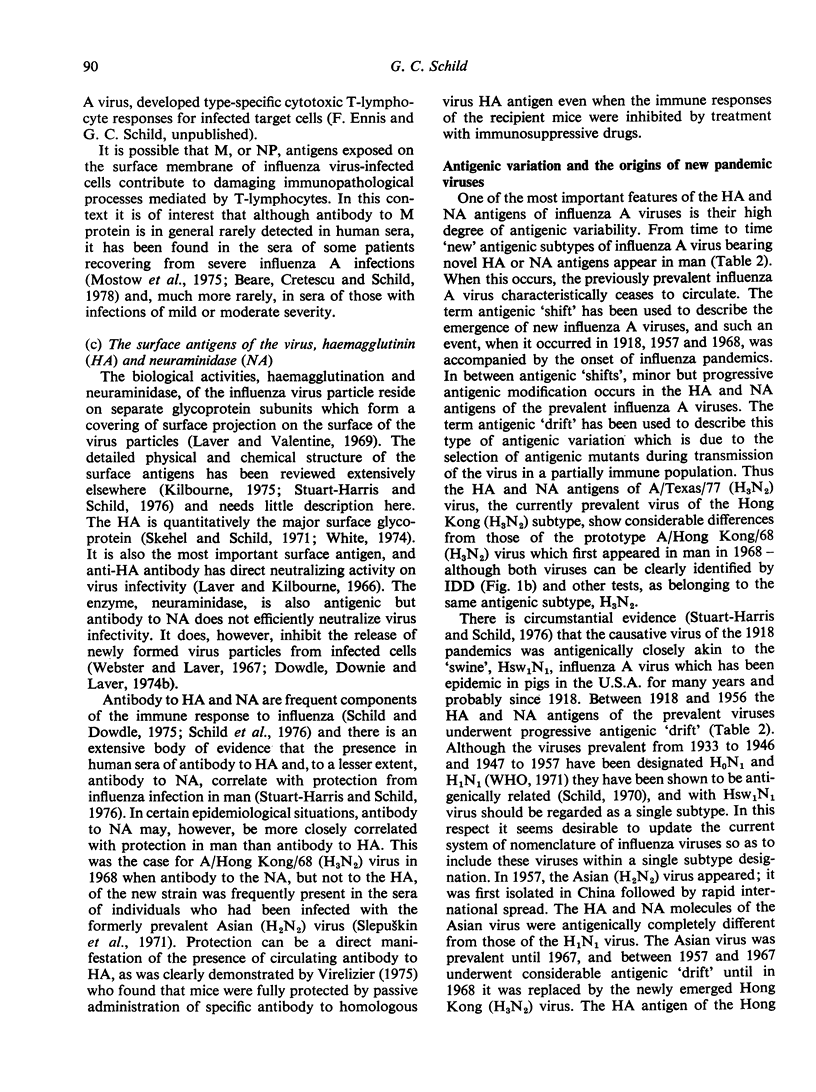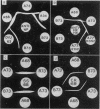Abstract
The architecture and chemical composition of the influenza virus particle is described with particular reference to the protein constituents and their genetic control. The dominant role in infection of the surface proteins - haemagglutinins and neuraminidases - acting as antigens and undergoing variation in time known as antigenic drift and shift is explained. The immuno-diffusion technique has illuminated the interrelationships of the haemagglutinins of influenza A viruses recovered over long periods of time. The H0 and H1 haemagglutinins are now regarded as a single sub-type with H2 and H3 representing the haemagglutinins of the 1957 and 1968 sub-types. Animal influenza viruses of pigs, horses and birds are described. A relation to human influenza strains has been shown to exist in certain instances as is the capacity of some human strains to pass to the animal kingdom.
Full text
PDF










Images in this article
Selected References
These references are in PubMed. This may not be the complete list of references from this article.
- Biddison W. E., Doherty P. C., Webster R. G. Antibody to influenza virus matrix protein detects a common antigen on the surface of cells infected with type A influenza viruses. J Exp Med. 1977 Sep 1;146(3):690–697. doi: 10.1084/jem.146.3.690. [DOI] [PMC free article] [PubMed] [Google Scholar]
- Braciale T. J. Immunologic recognition of influenza virus-infected cells. II. Expression of influenza A matrix protein on the infected cell surface and its role in recognition by cross-reactive cytotoxic T cells. J Exp Med. 1977 Sep 1;146(3):673–689. doi: 10.1084/jem.146.3.673. [DOI] [PMC free article] [PubMed] [Google Scholar]
- Coleman M. T., Dowdle W. R., Pereira H. G., Schild G. C., Chang W. K. The Hong Kong-68 influenza A2 variant. Lancet. 1968 Dec 28;2(7583):1384–1386. doi: 10.1016/s0140-6736(68)92683-4. [DOI] [PubMed] [Google Scholar]
- DAVENPORT F. M., HENNESSY A. V., FRANCIS T., Jr Epidemiologic and immunologic significance of age distribution of antibody to antigenic variants of influenza virus. J Exp Med. 1953 Dec;98(6):641–656. doi: 10.1084/jem.98.6.641. [DOI] [PMC free article] [PubMed] [Google Scholar]
- Doherty P. C., Effros R. B., Bennink J. Heterogeneity of the cytotoxic response of thymus-derived lymphocytes after immunization with influenza viruses. Proc Natl Acad Sci U S A. 1977 Mar;74(3):1209–1213. doi: 10.1073/pnas.74.3.1209. [DOI] [PMC free article] [PubMed] [Google Scholar]
- Dowdle W. R., Downie J. C., Laver W. G. Inhibition of virus release by antibodies to surface antigens of influenza viruses. J Virol. 1974 Feb;13(2):269–275. doi: 10.1128/jvi.13.2.269-275.1974. [DOI] [PMC free article] [PubMed] [Google Scholar]
- Dowdle W. R., Galphin J. C., Coleman M. T., Schild G. C. A simple double immunodiffusion test for typing influenza viruses. Bull World Health Organ. 1974;51(3):213–215. [PMC free article] [PubMed] [Google Scholar]
- Ennis F. A., Martin W. J., Verbonitz M. W. Hemagglutinin-specific cytotoxic T-cell response during influenza infection. J Exp Med. 1977 Sep 1;146(3):893–898. doi: 10.1084/jem.146.3.893. [DOI] [PMC free article] [PubMed] [Google Scholar]
- Kaplan M. M., Webster R. G. The epidemiology of influenza. Sci Am. 1977 Dec;237(6):88–106. doi: 10.1038/scientificamerican1277-88. [DOI] [PubMed] [Google Scholar]
- Kendal A. P., Noble G. R., Dowdle W. R. Swine influenza viruses isolated in 1976 from man and pig contain two coexisting subpopulations with antigenically distinguishable hemagglutinins. Virology. 1977 Oct 1;82(1):111–121. doi: 10.1016/0042-6822(77)90037-x. [DOI] [PubMed] [Google Scholar]
- Laver W. G., Downie J. C., Webster R. G. Studies on antigenic variation in influenza virus. Evidence for multiple antigenic determinants on the hemagglutinin subunits of A-Hong Kong-68 (H3 N2) virus and the A-England-72 strains. Virology. 1974 May;59(1):230–244. doi: 10.1016/0042-6822(74)90218-9. [DOI] [PubMed] [Google Scholar]
- Laver W. G., Kilbourne E. D. Identification in a recombinant influenza virus of structural proteins derived from both parents. Virology. 1966 Nov;30(3):493–501. doi: 10.1016/0042-6822(66)90125-5. [DOI] [PubMed] [Google Scholar]
- Laver W. G., Valentine R. C. Morphology of the isolated hemagglutinin and neuraminidase subunits of influenza virus. Virology. 1969 May;38(1):105–119. doi: 10.1016/0042-6822(69)90132-9. [DOI] [PubMed] [Google Scholar]
- McGeoch D., Fellner P., Newton C. Influenza virus genome consists of eight distinct RNA species. Proc Natl Acad Sci U S A. 1976 Sep;73(9):3045–3049. doi: 10.1073/pnas.73.9.3045. [DOI] [PMC free article] [PubMed] [Google Scholar]
- Mostow S. R., Schild G. C., Dowdle W. R., Wood R. J. Application of the single radial diffusion test for assay of antibody to influenza type A viruses. J Clin Microbiol. 1975 Dec;2(6):531–540. doi: 10.1128/jcm.2.6.531-540.1975. [DOI] [PMC free article] [PubMed] [Google Scholar]
- Nakajima K., Desselberger U., Palese P. Recent human influenza A (H1N1) viruses are closely related genetically to strains isolated in 1950. Nature. 1978 Jul 27;274(5669):334–339. doi: 10.1038/274334a0. [DOI] [PubMed] [Google Scholar]
- Oxford J. S., McGeoch D. J., Schild G. C., Beare A. S. Analysis of virion RNA segments and polypeptides of influenza A virus recombinants of defined virulence. Nature. 1978 Jun 29;273(5665):778–779. doi: 10.1038/273778a0. [DOI] [PubMed] [Google Scholar]
- Oxford J. S., Schild G. C. Immunological and physicochemical studies of influenza matrix (M) polypeptides. Virology. 1976 Oct 15;74(2):394–402. doi: 10.1016/0042-6822(76)90345-7. [DOI] [PubMed] [Google Scholar]
- Palese P., Schulman J. L. Differences in RNA patterns of influenza A viruses. J Virol. 1976 Mar;17(3):876–884. doi: 10.1128/jvi.17.3.876-884.1976. [DOI] [PMC free article] [PubMed] [Google Scholar]
- Palese P., Schulman J. L. RNA pattern of 'swine' influenza virus isolated from man is similar to those of other swine influenza viruses. Nature. 1976 Oct 7;263(5577):528–530. doi: 10.1038/263528a0. [DOI] [PubMed] [Google Scholar]
- Pons M. W., Schulze I. T., Hirst G. K., Hauser R. Isolation and characterization of the ribonucleoprotein of influenza virus. Virology. 1969 Oct;39(2):250–259. doi: 10.1016/0042-6822(69)90045-2. [DOI] [PubMed] [Google Scholar]
- SCHULMAN J. L., KILBOURNE E. D. INDUCTION OF PARTIAL SPECIFIC HETEROTYPIC IMMUNITY IN MICE BY A SINGLE INFECTION WITH INFLUENZA A VIRUS. J Bacteriol. 1965 Jan;89:170–174. doi: 10.1128/jb.89.1.170-174.1965. [DOI] [PMC free article] [PubMed] [Google Scholar]
- Schild G. C. Evidence for a new type-specific structural antigen of the influenza virus particle. J Gen Virol. 1972 Apr;15(1):99–103. doi: 10.1099/0022-1317-15-1-99. [DOI] [PubMed] [Google Scholar]
- Schild G. C., Henry-Aymard M., Pereira H. G. A quantitative, single-radial-diffusion test for immunological studies with influenza virus. J Gen Virol. 1972 Aug;16(2):231–236. doi: 10.1099/0022-1317-16-2-231. [DOI] [PubMed] [Google Scholar]
- Schild G. C., Pereira H. G. Characterization of the ribonucleoprotein and neuraminidase of influenza A viruses by immunodiffusion. J Gen Virol. 1969 Apr;4(3):355–363. doi: 10.1099/0022-1317-4-3-355. [DOI] [PubMed] [Google Scholar]
- Schild G. C., Pereira M. S., Chakraverty P. Single-radial-hemolysis: a new method for the assay of antibody to influenza haemagglutinin. Applications for diagnosis and seroepidemiologic surveillance of influenza. Bull World Health Organ. 1975;52(1):43–50. [PMC free article] [PubMed] [Google Scholar]
- Schild G. C., Smith J. W., Cretescu L., Newman R. W., Wood J. M. Strain-specificity of antibody to haemagglutinin following inactivated A/port chalmers/1/73 vaccine in man: evidence for a paradoxical strain-specific antibody response. Dev Biol Stand. 1977 Jun 1;39:273–281. [PubMed] [Google Scholar]
- Schild G. C. Studies with antibody to the purified haemagglutinin of an influenza Ao virus. J Gen Virol. 1970 Dec;9(3):191–200. doi: 10.1099/0022-1317-9-3-191. [DOI] [PubMed] [Google Scholar]
- Scholtissek C., Rohde W., Von Hoyningen V., Rott R. On the origin of the human influenza virus subtypes H2N2 and H3N2. Virology. 1978 Jun 1;87(1):13–20. doi: 10.1016/0042-6822(78)90153-8. [DOI] [PubMed] [Google Scholar]
- Skehel J. J., Schild G. C. The polypeptide composition of influenza A viruses. Virology. 1971 May;44(2):396–408. doi: 10.1016/0042-6822(71)90270-4. [DOI] [PubMed] [Google Scholar]
- Slepushkin A. N., Schild G. C., Beare A. S., Chinn S., Tyrrell D. A. Neuraminidase and resistance to vaccination with live influenza A2 Hong Kong vaccines. J Hyg (Lond) 1971 Dec;69(4):571–578. doi: 10.1017/s0022172400021847. [DOI] [PMC free article] [PubMed] [Google Scholar]
- Virelizier J. L., Allison A. C., Oxford J. S., Schild G. C. Early presence of ribonucleoprotein antigen on surface of influenza virus-infected cells. Nature. 1977 Mar 3;266(5597):52–54. doi: 10.1038/266052a0. [DOI] [PubMed] [Google Scholar]
- Virelizier J. L., Allison A. C., Schild G. C. Antibody responses to antigenic determinants of influenza virus hemagglutinin. II. Original antigenic sin: a bone marrow-derived lymphocyte memory phenomenon modulated by thymus-derived lymphocytes. J Exp Med. 1974 Dec 1;140(6):1571–1578. doi: 10.1084/jem.140.6.1571. [DOI] [PMC free article] [PubMed] [Google Scholar]
- Virelizier J. L. Host defenses against influenza virus: the role of anti-hemagglutinin antibody. J Immunol. 1975 Aug;115(2):434–439. [PubMed] [Google Scholar]
- Virelizier J. L., Oxford J. S., Schild G. C. The role of humoral immunity in host defence against influenza A infection in mice. Postgrad Med J. 1976 Jun;52(608):332–337. doi: 10.1136/pgmj.52.608.332. [DOI] [PMC free article] [PubMed] [Google Scholar]
- Virelizier J. L., Postlethwaite R., Schild G. C., Allison A. C. Antibody responses to antigenic determinants of influenza virus hemagglutinin. I. Thymus dependence of antibody formation and thymus independence of immunological memory. J Exp Med. 1974 Dec 1;140(6):1559–1570. doi: 10.1084/jem.140.6.1559. [DOI] [PMC free article] [PubMed] [Google Scholar]
- Webster R. G., Hinshaw V. S. Matrix protein from influenza A virus and its role in cross-protection in mice. Infect Immun. 1977 Sep;17(3):561–566. doi: 10.1128/iai.17.3.561-566.1977. [DOI] [PMC free article] [PubMed] [Google Scholar]
- Werner G. H. Immunité croisée hétérotypique chez la souris entre virus grippaux humains de types A et A2. C R Acad Sci Hebd Seances Acad Sci D. 1966 Dec 7;263(23):1913–1916. [PubMed] [Google Scholar]



